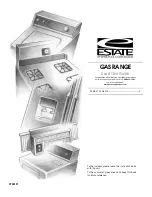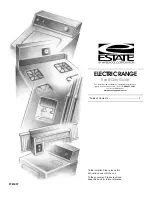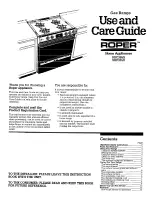
19
Before you call
Solutions to Common Problems
POSSIBLE CAUSE/SOLUTION
(1)
Poor installation. Place oven rack in center of oven. Place a level on the oven rack. Adjust leveling legs at
base of range until the rack is level. When range is level, cooktop may appear out of alignment if countertop
is not level.
(2)
Weak, unstable floor. Be sure floor is level and can adequately support range. If floor is
sagging or slopping, contact a carpenter to correct the situation.
(3)
Kitchen cabinet misalignment may make
range appear to be unlevel. Be sure cabinets are square and have sufficient room for range clearance.
(1)
Cabinets not square or are built in too tight. Contact a cabinet maker to correct the problem.
(2)
Contact
builder or installer to make appliance accessible. (3) Carpet interferes with range. Provide sufficient space
so range can be lifted over carpet.
(4)
Gas line is hard-plumbed. Have a flexible C.S.A international
approved metal appliance connector installed.
(1)
Make sure cord/plug is plugged tightly into outlet.
(2)
Service wiring is not complete. Call an authorized
servicer.
(3)
Electrical power outage. Check house lights to be sure. Call your local electric company for
service. Surface burners can be lit manually.
(1)
Electronic control has detected a fault condition. Press
STOP/CLEAR
to clear the display and stop
beeping. Reprogram oven. If fault recurs, record fault number. Press
STOP/CLEAR
and call an authorized
servicer for assistance.
(1)
Replace or tighten bulb. See
Changing Oven Light
section in this Use & Care Guide.
(2)
Electrical power
outage. Check house lights to be sure. Call your local electric company for service.
(1)
Surface control knob has not been completely turned to LITE. Push in and turn the surface control knob to
LITE until burner ignites and then turn the surface control knob to the desired flame size.
(2)
Burner ports are
clogged. Clean burners. See “Cleaning the Burner Grates, Burner Caps and Burner Heads” under General
Cleaning.
(3)
Range power is disconnected from outlet. Be sure cord is securely plugged into the outlet.
(4)
Electrical power outage.
(5)
Be sure the gas supply to the range is turned “ON”.
(1)
Burner ports or slots are clogged. With the burner off, use a small-gauge wire or needle to clean ports or
slots.
(2)
Moisture is present after cleaning. Lightly fan the flame and allow the burner to operate until flame is
full. Dry the burners thoroughly following instructions under General Cleaning.
(1)
Dust particles in main line. Allow the burner to operate a few minutes until flame turns blue.
(2)
Salt air in
coastal areas. A slightly orange flame is unavoidable.
(1)
Many factors affect baking results. Make sure the proper rack position is used. Center food in the oven
and space pans to allow air to circulate. Allow the oven to preheat to the set temperature before placing food
in the oven. Try adjusting the recipes’ recommended temperature or baking time. If you feel the oven is too
hot or cool, see
“Recalibrating Your Oven Temperature”
section in the Electronic Oven Control Guide.
(1)
A cooling fan may automatically turn on and off to cool internal parts. It is normal, and the fan may
continue to run even after oven is turned off.
(1)
Excessive spillovers in oven. Set self-clean cycle for a longer cleaning time.
(2)
Excessive spillovers in
oven. This is normal, especially for pie spillovers or large amounts of grease on the oven bottom. Wipe up
excessive spillovers before starting the self-clean cycle. If flames or excessive smoke are present, stop the
self-clean cycle and follow the steps under
"Stopping or Interrupting the Self-Cleaning Cycle"
in the
Electronic Oven Control Guide.
(1)
Meat is too close to the element. Reposition the rack to provide proper clearance between the meat and
the oven boil element.
(2)
Meat is not properly prepared. Remove excess fat from meat. Remove remaining
fatty edges to prevent the meat from curling, but do not cut into the lean of the meat.
(3)
Broiler pan used
without the Broiler Pan Insert or insert is covered with foil. DO NOT use the Broiler Pan without the Broiler
Pan Insert or cover the insert with foil.
(4)
Broiler Pan or Broiler Pan Insert needs to be cleaned. Excessive
smoking is caused by buildup of grease or food spatters. Clean the Broiler Pan and Insert on a regular basis.
(5)
Oven door is open. Oven door should be closed when broiling.
(1)
Control(s) not set properly. Follow instructions under
“Oven Cleaning”
in the Electronic Oven Control
Guide. (2) Self-cleaning cycle was interrupted. Stop time must be 2 to 4 hours past the start time. Follow
steps under
"Stopping or Interrupting the Self-Cleaning Cycle"
in the Electronic Oven Control Guide.
(1)
Set Self-Clean cycle for a longer cleaning time.
(2)
Failure to clean bottom front, top of oven or door areas
outside oven seal. These areas are not in the Self-Cleaning area, but get hot enough to burn on food
residue. Clean these areas before starting the Self-Clean cycle. Burned-on residue may be cleaned with a
stiff nylon brush and water or nylon scrubber. Be careful not to damage the oven gasket.
(1)
Excessive spillovers in oven, especially for pie spillovers or large amounts of grease on the oven bottom.
Wipe up excessive spillovers before starting the Self-Clean cycle. If flames or excessive smoke are present,
stop the Self-Clean cycle and follow the steps under
"Stopping or Interrupting the Self-Cleaning Cycle"
in
the Electronic Oven Control Guide.
OCCURRENCE
Range is not level.
Cannot move appliance
easily. Appliance must
be accessible for
service.
Entire range or oven
does not operate.
*Oven control beeps and
displays any F code
error (for example F11)
Oven light does not
work.
Surface burners do not
light.
Surface burner flame
burns half way around.
Surface burner flame is
orange.
Poor baking results.
Fan noise during
cooking operation.
Flames inside oven or
smoking from vent.
Oven smokes
excessively during
broiling.
Self-cleaning cycle does
not work.
Soil not completely
removed after self-
cleaning cycle.
Excessive smoking
from oven vent.


































